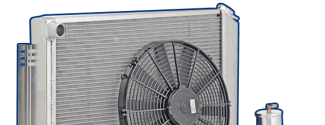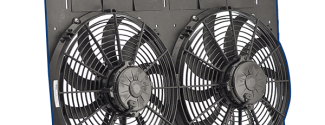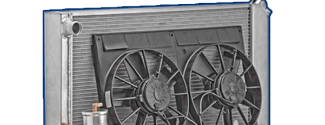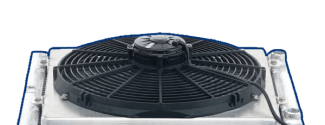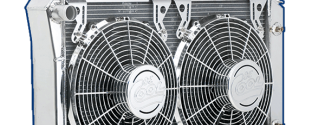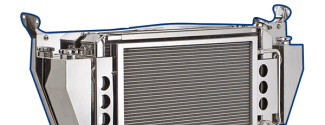FAQS
RADIATORS
Is a Be Cool radiator expensive?
In a word: No. Typically a Be Cool radiator only costs about 10% of what a customer has invested in their engine (i.e., $7,500 engine, $750 radiator) yet it adds immeasurably to the enjoyment and usability of their vehicle. It also is a very effective insurance policy. If a customer has more than $7,500 invested in their engine, the Be Cool radiator is an even better buy, percentage wise.
How and why can Be Cool guarantee a water temperature drop?
Be Cool's modern technology combined with proper core sizing is sufficient to cool any vehicle as long as the Be Cool application guide has been followed. However, sufficient airflow, water flow speed, and correct ignition timing are a must.
Should my water speed be decreased?
No! You should avoid using underdrive engine pulleys which slow water speed.
Why is it important that Be Cool radiators are epoxy-free?
First and foremost, epoxy acts as an insulator and reduces the cooling efficiency of the core. Be Cool's radiator cores are CAB (Controlled Atmosphere Brazing) brazed and 100% leak tested to guarantee an excellent tube to header bond. This eliminates the need for any epoxy.
Why does a Be Cool direct-fit radiator sometimes cost more than other "universal" performance radiators?
It doesn't cost more if you compare apples to apples. The fabrication time and expense required to adapt other "universal" performance radiators will usually exceed the cost of a Be Cool direct-fit radiator. A Be Cool direct-fit radiator is designed to minimize installation hassles and maximize cooling efficiency.
In addition to direct-fit radiators, Be Cool offers universal-fit radiators at a lower cost. Are they a better buy?
As in the answer above, a universal-fit radiator plus fabrication expense will usually cost more than a direct-fit radiator. Only purchase a universal-fit radiator when there is no direct-fit application available for your vehicle. Be Cool universal radiators are recommended for up to 300 dyno-rated horsepower.
Is there an advantage to Be Cool's hand fabricated .080 wall, 5052 alloy aluminum tanks compared to the old-fashioned OEM-style stamped tanks of other performance radiators?
Tanks made of .080 wall, 5052 alloy aluminum create a nice billet-look in their natural state and lend themselves well to polishing if the customer desires. Tanks walls made of .080 wall, 5052 alloy aluminum are thicker than stamped tanks. Stamped tanks are prone to leaks if polished because the stamping process naturally creates some areas (such as corners) where the material has been "thinned." Thicker, sturdier tanks also help prevent ballooning.
Isn't copper a better heat dissipater than aluminum? If so, why isn't a copper/brass/lead radiator more efficient than an aluminum one?
Copper is a more efficient heat dissipater than aluminum. However, the other components in a copper/brass/lead radiator minimize its overall effectiveness and actually make an aluminum radiator more efficient. As much as 25% more efficient.
How thick is a Be Cool radiator?
Single core Be Cool radiators are 1 inch thick and all dual core Be Cool radiators are 2 inches thick.
Why doesn't Be Cool offer dual core radiators with 1 1/4" or 1 1/2" tubes?
The thicker the radiator, the more difficult it is to pass air all the way through the radiator. No performance gains were seen at low speeds (where it is needed most) and some vehicles actually ran warmer when Be Cool tested thicker radiators in the R&D department.
Why would a customer convert to a crossflow radiator if his vehicle originally came with a downflow radiator?
Crossflow radiators are more efficient than downflow radiators because the pressure cap is positioned on the low-pressure side in a crossflow configuration. This allows sustained high RPM operation without forcing fluid past the cap. Also, under-hood space considerations often allow crossflow radiators to use a larger core that has more surface area. This is more efficient and results in more effective cooling. The larger cross flow area allows the radiator's capacity to be increased. Always update to a crossflow conversion if it is offered for an original downflow application. This is very similar to exchanging a vehicle's original drum brakes for more modern, and thus efficient, disc brakes.
Does a Be Cool radiator require a new or special cap?
A new cap is always recommended because it seats properly and helps to guarantee a trouble-free installation. An old cap has "taken a seat" from the filler neck of the previous radiator. Use a new, 12-15 psi GM-style or Be Cool billet cap. Use Be Cool part number 70001 or 70002 for natural-finish installations and part number 71001 or 71002 for polished-finish installations.
Why and when does Be Cool use a billet filler neck?
CNC precision machined billet filler necks are installed on all Be Cool radiators. These filler necks will always seal better and look nicer than cast or stamped ones. Tolerances are held closer and fabrication is improved, virtually eliminating any neck to tank leaks. The billet filler neck also has a larger overflow tube for increased coolant flow to the recovery tank.
Does Be Cool recommend a coolant recovery tank?
Yes, Be Cool recommends a coolant recovery tank in every installation. Recovery tanks will eliminate all air in the system and in many cases improve the performance of the cooling system. As with radiator caps, Be Cool offers high-style recovery tanks in natural finish (#70003 & 70058) or polished finish (#71003 & 71058) for those who desire to complete their installation in the ultimate fashion.
What does Be Cool recommend for coolant?
Be Cool recommends a major brand, OEM grade, 5-year coolant such as an ethylene glycol based coolant. Use a mixture of 60% ethylene glycol based coolant and 40% distilled water after thoroughly flushing all of the old coolant. Distilled water is important because it has no chemicals or impurities.
What about additives?
Be Cool doesn't recommend it but, if you must use an additive, you should avoid using any that have a high alcohol content.
Are there any specific thermostat recommendations?
Yes. Use a high quality, high-performance thermostat like Be Cool's 78000 series thermostats. These units increase water flow and guarantee proper function.
Is it mandatory to use the automatic transmission cooler in the radiator or is an external cooler acceptable?
The transmission fluid cooler in a radiator is designed to do two things:
- To bring the transmission fluid up to the proper operating temperature.
- To keep the transmission fluid at the proper operating temperature after the initial warm up.
If you desire to run an external cooler, (i.e., cars with high stall torque converters) Be Cool recommends that you route the cooling lines from the transmission to the external cooler and then to the cooler in the radiator. For optimum cooling efficiency mount the external cooler off to the side of the radiator. This will allow maximum airflow to reach the radiator.
FANS
Why does Be Cool recommend an electric cooling fan?
Electric fan(s) move more cubic feet per minute (cfm) of air than the standard engine driven (mechanical) fan that comes on most vehicles. At idle and low speed a mechanical fan slows down with the engine rpm and decreases airflow where the electric fan(s) maintain consistent speed regardless of engine rpm. This increases cooling at idle and low speeds. The horsepower and fuel economy gained by switching to an electric fan(s) is substantial. A mechanical fan is always turning and draining engine power, while electric fan(s) only turn on when needed.
Should I mount my electric fan in front of or behind the radiator?
If space permits it is always better to have your fan operate as a "puller" by mounting it on the water pump side of the radiator. A "puller" electric fan is approximately 15% more efficient than a "pusher" electric fan.
What is the proper way to mount an electric fan?
Using Be Cool's brackets and cushions is the best way. Tie-strap mounted electric fans are particularly hard on a radiator core and void Be Cool's radiator warranty. Please see the warranty information packed with the radiator for full details and be sure to register the warranty with Be Cool.
What is the ultimate way to hook up an electric fan?
Use a fan wiring kit and a brass sensor for your water coolant temperature. You can wire a relay to turn the fan on at 195 degrees and off at 175 degrees or use an adjustable fan wiring kit. Be Cool offers both fixed and adjustable fan wiring kits.
Is there any other way to hook up an electric fan?
Yes. You can wire, with a proper relay, a manual control switch and turn the electric fan on and off at your discretion.
MODULES
What is a Be Cool Module Assembly?
A Be Cool Module Assembly is a pre-selected combination of specific Be Cool power cooling components that produce a guaranteed result.
Why does a Be Cool Module Assembly work so much better than the original style cooling system it replaces?
A Be Cool Module Assembly is the combination of a dual row aluminum radiator (except for a few single core applications), an electric fan(s), and related components. The Be Cool radiator core has specially designed louvered fins and tubes. The fins are designed for maximum heat dissipation and the tubes have 31% more surface area for cooling than older four-row copper/brass/lead cores. Additionally, Be Cool radiators generally have more coolant capacity than the equivalent copper/brass/lead radiators. Unlike copper/brass/lead radiators, fabricated aluminum radiators act entirely as a cooling unit with the tanks doing some of the heat dissipation.
Why do I need a Be Cool Module Assembly?
Be Cool has taken the guesswork out of achieving cooling satisfaction by including in one box everything that is needed to cool a vehicle when the specific dyno-rated horsepower output of that vehicle is known.
Do you make a Module Assembly for my vehicle and will it fit my vehicle properly?
Consulting the Be Cool Radiator Application Guide will answer this question quickly and correctly. The guide has been put together with great care and thoroughness. Additionally, any information contained in the fitment section at this time will help define any potential complications right up front. Knowing about different hose requirements, shroud modifications, etc. can go a long way towards preventing "Weekend Installation" problems.
Will your Module Assembly cool my vehicle?
If you have used the Application Guide properly and the search has returned a recommendation or our technical support staff has given you a part number to use, then Be Cool guarantees results or we'll give you your money back.

